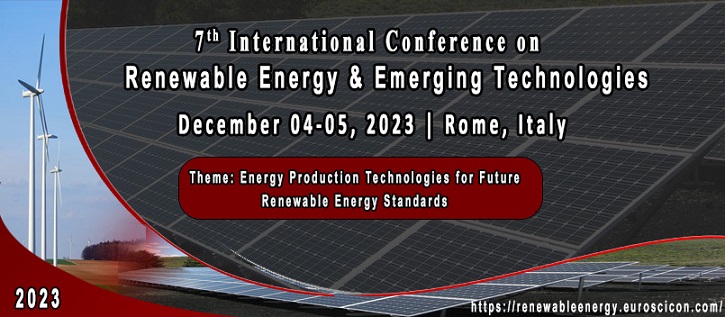RENEWABLE ENERGY 2023
About Conference
About the Conference
Welcome to Rome, Italy, the Metropolitan City with a rich cultural heritage spread throughout the corners. Experience the core the renewable energy as never before EuroScicon is proud to host the 7th International conference on Renewable Energy & Emerging Technologies 2023 with the theme of “Energy Production Technologies for Future Renewable Energy Standards”. We are there to host you on December 04-05, 2023, in Rome, Italy. Renewable Energy will widely elucidate the various spectrum of renewable energy through its dignified environmentalists, distinguished professors, scientists along with students, young researchers. It will be a golden platform for the young minds to showcase their research and present and meet the experts. It will provide an environment conducive to education and interaction.
With broad array of keynote presentations, panel discussions, workshops, poster sessions, the Renewable Energy 2023 is the perfect venue not only to dive into the particular renewable energy but also to expand the scope of your knowledge. 26 tracks are designed focussing on Sources of energy, Biomass, Geothermal, Hydropower, Solar Energy, Tidal Power, Hydrogen Economy, Renewable Energy, Sustainable Energy, Green Energy, Chemical Batteries, Future Challenges and Emerging technologies.
The Organizing Committee has done its best to set up a framework that we think will allow for a creative interplay of ideas. All we need now to convert the extensive program on paper to an active and vibrant renewable energy forum in person is your active participation.
List of Journals:
Environmental Science: An Indian Journal
Research & Reviews: Journal of Ecology and Environmental Sciences
Journal of Fundamentals of Renewable Energy and Applications
Innovative Energy & Research
Journal of Nuclear Energy Science & Power Generation Technology
About Hosting Organization
EuroSciCon is one among Europe’s largest and most significant scientific place which serves as a crossroad for the academicians and industry experts to build networks. With over 16 years of Life Science Communication it focuses on to Spearheading the Transformation of Medical Research into Knowledge through Scientific Gatherings and Networking. Supporting the Rare Care UK organization. Our approach has always been unique, and that difference has propelled our growth towards Scientific Serendipity.
Why attend Renewable Energy 2023?
Why attend Renewable Energy 2023?
The upcoming meeting Renewable Energy 2023 is a global platform to learn more and more about our natural energy sources in depth. It discusses the renewable energy at a wider scale with all the innovations, recent trends, future challenges and emerging trend in this field. The Experts will be brightening up on the boon and the related concern to a wider scale. It not only brings out the intellects thoughts but also provide the stage to the young upcoming minds with their new innovations and briefing their curiosity. It is a place to share the knowledge with the like minded people gathering together from around the globe.
Quick insight of the upcoming Renewable Energy 2023, at Rome, Italy:
- Meet the Naturalists and Environmentalists from 25+ countries around the globe
- Earn up to 21 CME/ CPD credits
- Meet your peers and evaluate your research in front of experts
- World-class platform to exhibit your products and services
- Special Workshop/ Symposiums, B2B and interactive sessions with industry Sponsors and Exhibitors
- More than 25 presentations from Industry and Academia leaders
- One- on -one interaction, B2B, and B2A etc.
- Well organized program with 5+ hours of networking sessions
- Interactive panel discussions and Q&A sessions
- Lively Exhibition area filled with the leading industry solution provider
- Congregate with most senior executives
- Nurture connections
- Agenda format which incorporates ample Q&A time
- Partake in our revamped exhibitor expo sessions
- Meet and listen to the relevant clients
- Unprecedented growth creating an unparalleled market place
Who should attend?
Who should attend?
7th Edition of International conference on Renewable Energy & Emerging Technologies plays host for the Multinational organizations, entrepreneurs across the globe, the researchers and academicians. Prominently Ecologist, Naturalist, Environment Consultants, Regulatory Professionals, Distinguished Professors, Forensic Scientists and others who stay plunged in learning and practice of the science of renewable energy. This event will be providing a new platform to the students, delegates, young researchers associated to any spectra of Renewable energy and its associated scope.
Beside the academicians, we are also inviting the business class with the key interest in the renewable energy sources. All those having there area of interest in:
Algae Fuels
Artificial Photosynthesis
Clean energy
Drones
Enhanced Geothermal Energy
Liquid metal Batteries
Offshore Wind
Pumped Storage Hydro
Renewable Jet Fuels
Solar updraft tower
Solar assisted heat pump
Space based Solar Power
Wind Turbines
Top companies associated with Renewable Energy
7C Solarparken
ABB Ltd
Anwell Technologies
Atlantica Yield PLC (ABY
Brookfield Renewable Energy Partners LP
Carnegie Wave Energy, LTD
Centrosolar Group, AG
DayStar Technologies, INC
Dongfang Electric
Enel Green Power S.p.A.
EnerDynamic Hybrid Technologies Inc.
Finavera Renewables, INC
Gevo, Inc.
Gintech Energy Corporation
Iberdrola Renovables, SA
JA Solar Holdings Co, LTD
Kedco PLC
LDK Solar Co, LTD
Neo Solar Power Corporation
Ocean Power Technologies, INC
Phoenix Solar, AG
Ram Power, Corp.
Renewable Energy Generation, LTD
Suzhou Shenglong PV-Tech Co.Ltd
Vestas Wind Systems A/S (VWDRY)
Tracks
Track 1. Renewable Energy
Meeting with the world wide expectation, renewable energy has evolved a lot. The use of renewable can be seen in day to day life basically in four areas electricity generation, air and water heating and cooling transportation and rural(off-grid) energy services. The existence of this energy has been find across wide geographical area as compared to other energy sources. Large application of renewable energy has resulted in significant improvement in energy security, climate change mitigation and economic benefits. The use of renewable energy has directed the people to move forward from conventional fuels due to the environmental reasons. Renewable energy can be defines as a form of energy derived from the natural sources which cannot be depleted such as wind or solar power. They are the natural energy present in all forms ranging from sunlight, wind, waves, geothermal heat and tides. There sources are replaced constantly but does not get short. Although there is unlimited supply of the fossil fuels, we should go for the use of renewable energy as it is not only safe for the environment, eco-friendly but also less prone to pollutants if any. The development in renewable technologies has led to human development both way rural and urban. A single form of renewable energy can be further converted into different forms. It won’t be wrong to say that renewable energy is leading to sustainable development.
Track 2. Climate Change & Renewable Energy
Sustainable power source is a standout amongst the best devices we have in the battle against environmental change, and there is each motivation to trust it will succeed. An on-going New York Times segment appears to suggest that sustainable power source speculations set back endeavours to address environmental change—nothing could be further from reality. In addition, inexhaustible innovations can progressively spare clients cash as they uproot discharges from petroleum derivatives. Environmental change can truly have a ton of negative outcomes. It is vital to make a move to help diminish the measure of progress that happens and make it not occur so quickly. Eventually, the earth will be excessively hot for individuals, making it impossible to live serenely on the off chance that we don't roll out a few improvements. It is as of now having sway on the plant and creature life, and in the event that you truly would prefer not to see it deteriorate the time has come to become environmentally friendly. The nonstop increment of nurseries gases in the air have made temperature rise which is called as nursery impact. In spite of the fact that nursery impact is fundamental for survival of every one of us on this planet however increment of these gases past a point of confinement will just make hurtful impacts for us and this condition. Amid a century ago, earth's normal temperature ascended by 1 degree Fahrenheit which in itself is a reason for concern.
Track 3. Sources of energy
One of the advantageous factors for the use of the renewable energy is that it is naturally generated. These sources are constantly replenished such as sunlight, wind, heat and water. The common energy sources are Hydropower, Biomass, Biofuels, Wind, Geothermal and Solar Energy. It often includes commodities such as wood, paper and leather. The sources of renewable energy are present in the natural environment comprising the largest component of ecosystem. These sources are capable enough to replace the conventional sources of energy such as fossil energy by serving into distinct areas such as generation of electricity, Hot water/space heating, motor fuels, and the rural grid off energy services.
Track 4. Biofuels:
One of the most prominent and promising renewable energy Biofuels can be converted directly to the liquid fuels. Biofuels is widely used for the transportation. There are various types of Biofuels such as Ethanol, Biodiesel, Bioalcohols, Green Diesel, and Biofuel gasoline, Vegetable Oil, Bioethers, Biogas, Syngas and Solid Biomass Fuels. Ethanol and Biodiesel are the commonly used biofuels. The main aim for introducing Biofuels was to replace Gasoline, Diesel Fuel and Coal. Green Diesel, Biogas. It is having enormous advantage when compared with the fossil fuels such as less greenhouse gases providing greater fuel securities. The use of Biofuel is widely dependent on the land availability. It is made from biological agents such as plant oils or animal through the set of chemical reactions. One of the major advantages for using the Biofuel is that they are renewable energy and don not lead to global warming unlike the fossil fuels. According to few facts, Biofuels is the only renewable energy which can replace the fossil fuels.
Track 5. Biomass
A renewable form and sustainable form of energy that is used for the generation of electricity or other forms of power is called as Biomass. Sun is the main source for Biomass. Through the process of photosynthesis, plant absorbs the suns energy. When this biomass is burned , due to the chemical energy certain heat is released. It can be directly converted to liquids biofuels or biogas or even burned directly. Burning is the only process for releasing energy in biomass. This renewable form of energy can be converted to other useable forms such as methane gas or for transportation purposes like ethanol and Biodiesel. Around 5% of the prime usage of energy is served by Biomass. Wood, Wood waste, Straw, Manure, Sugarcane and many other agricultural goods are the prime source for the Biomass. Municipal solid waste also comprises of the biomass. Biomass in the form of dead plants, trees, grass, leaves, crops, manure, garbage’s, animals waste can be a great source of alternative fuels that can be used to replace fossil fuels. Burning either fossil fuels or biomass releases carbon dioxide (CO2), a greenhouse gas. However, the plants that are the source of biomass capture a nearly equivalent amount of CO2 through photosynthesis while they are growing, which can make biomass a carbon-neutral energy source.
Track 6. Geothermal Energy
Heat generated from the earth s surface is called as geothermal heat. This form of energy is the clean and sustainable. They can be from the shallow ground to hot water and hot rock found beneath the earth surface, also found extremely deeper to the extremely high temperatures of molten rock called magma. It is the clean energy. Usually the heat pumps have 3-4.5 COPs that means 3-4.5 unites are used for supplying the heat. Geothermal heat pump is having 400% efficiency as compared to the fossil fuel furnace which is having the energy efficiency of 78-90 %. With all the possible advantages there is a con with the geothermal heat that in the extreme conditions it can also cause earthquake. The sustainability of geothermal energy is highly dependent on proper management of the reservoirs. With these minor issues, Geothermal is having the massive worldwide potential of 2 terawatts (TW). It also gives the less fluctuation cost with stable electricity cost.
Track 7.Hydropower
One of the most important and large source of renewable energy, Hydropower contributes to 10% of world electricity generation. The flowing water energy is converted to electricity in the hydropower plants. Most commonly the dam water is used. Flowing water through turbines ii used for the power generation. Although there is no air emission however water quality and wildlife habitats can be affected. Work is going on to design the power plants in such a way that it causes minimum affect to the river water. Undoubtedly it improves the wildlife’s river habitat but at the same time cause the reduction in power plant output. Sometimes this power plant hinders the life of the fishes so different approaches are employed such as fish ladders and improved turbines to assist the migration of fishes and lower their death rate.
Track 8. Solar Energy
Sun is the ultimate and the natural source of energy for all the available fuels. From thousands year suns ray has been used for providing warmth and serving the purpose of drying. The solar system don not produces air pollutants and they also have the minimum impact on environment. There is quite variation in the amount of sunlight that reaches the earth surface depending on the location, time of day, season of the year and weather conditions. Various solar technologies are there that directly tap the infinite power of sun and which is further used to produce heat, light and power. There are various Solar techniques such as Passive Solar Lighting and Heating, Solar Water Heating, solar Electricity and Solar Thermal Electricity. Solar Thermal electricity not only provides the heat but also generates the electricity. Solar energy can be converted to electricity in two ways i.e, Photovoltaic and Solar Power Plants. Photovoltaic (PV devices) or “solar cells” that change sunlight directly into electricity. PV systems are often used in remote locations that are not connected to the electric grid. They are also used to power watches, calculators, and lighted road signs. Solar Power Plants indirectly generate electricity when the heat from solar thermal collectors is used to heat a fluid which produces steam that is used to power generator.
Track 9. Tidal Power
Tidal Power or Tidal energy is the form of energy that converts the energy generated through the tides into the useful form mainly electricity. Tidal energy is not so common as compared to other forms of renewable energy. Tidal steam generators are there that converts the energy into electricity. There is kinetic energy present in the flowing water which is generated due to the change in tide. Same kinetic energy is converted into electricity. The energy form the tidal is could decrease the usage of nuclear power if associated to the radiation risks. Nearly 3,800 terawatt-hours energy is produced by tidal power yearly. However it’s expensive to derive the electricity from tidal energy costing around US$15 Billion. South Korea, France, United Kingdom, Scotland tops in the list of world’s biggest tidal power. Although not used widely, tidal power can be used in the future for the electricity generation. Tidal power has less availability as compared to other renewable sources due to the high cost and limited availability of sites with sufficiently high tidal ranges or flow velocities. There has been many technological developments and improvements which has resulted in the higher availability of the tidal power plants. Many revised design(e.g. dynamic tidal power, tidal lagoons) and Turbine technology(e.g. new axial turbines, cross flow turbines) have been introduced with aim of promoting the availability and accessibility of the tidal plants across.
Track 10. Wave Power
This form of energy is produced when the electricity generators are placed on the surface of the ocean. The energy is widely applied for the desalination purpose in the power plants and water pump. Output of the energy is calculated by the wave height, wave speed, wavelength and the water density. Energy generated by waves is converted into electricity through the electric generator. Wave movement is harnessed and converted to electricity. It’s a reliable source of energy as it can be harnessed enormously and there is no shortage. Depending on the method used for the capture of wave energy, it can be characterised into hydraulic ram, elastomeric hose pump, and pump to shore, hydroelectric turbine, air turbine and linear electric generator. Being a renewable source of energy, wave energy can have certain disadvantages to the marine animals. There are chances that the marine animal may be struck to the tidal turbine blades, causes noise pollution, effect on the life of marine animal, affecting the sediment transport and water quality.
Track 11. Wind Energy
One of the alternatives used against fossil fuels. Wind power is plentiful, renewable, widely distributed, clean without any emission of greenhouse gases. It often uses less land with less water consumption. Air flow through the wind turbines is converted to the electrical energy using the power generators. The energy in the wind turns two or three propeller-like blades around a rotor. The rotor is connected to the main shaft, which spins a generator to create electricity. This form of energy is used for the electricity generations which either uses the warm surface water or boiling the sea water turning it to the turbine further activating the generator. There are no fuel costs, no harmful gases are produced but it may cause noise pollution to the surrounding people. Starting from the ancient times, wind energy has been used for water pumping, drying and grinding. With the advancement in technology, the wind energy generated from the wind turbine can be used for the electricity generation. Wind energy doesn't contaminate the air like power plants that depend on burning of petroleum products, for example, coal or gaseous petrol. Wind turbines don't deliver air discharges that lead to medical issues like asthma or make corrosive rain or nursery gasses.
Track 12. Photovoltaic
Also called as Solar Cells, Photovoltaic cells (PV Cells) convert the sunlight directly into the electricity. By using the cells, Solar PV systems convert the sunlight into electricity. The cell system comprises of one or two layers of a semi conducting material mainly Silicon. Electric field is generated as soon as the light shines on the cells. At the point when light energy strikes the sunlight based cell, electrons are thumped free from the particles in the semiconductor material. In the event that electrical conveyors are joined to the positive and negative sides, framing an electrical circuit, the electrons can be caught as an electric current - that is, power. PV system comprises of PV Modules, Books on PV, Disconnects, Solectria inverter on a Prewired Power Panel, Deep Cycle Battery, C40 Charge Controller and a Midnight PV3 Combiner Box. The performance of a Solar cell is measured depending on it productivity to transform daylight into power. Just daylight of specific energies will work productively to make power, and quite a bit of it is reflected or consumed by the material that makes up the cell. Along these lines, a run of the mill business sun oriented cell has a proficiency of 15%-around one-6th of the daylight striking the cell produces power. Low efficiencies imply that bigger clusters are required, and that implies higher cost.
Track 13. Hybrid renewable energy Sources
With the increasing demand of Renewable energy, Hybrid Renewable Energy Sources (HRES) has been used widely in the remote areas. HRES involves combining of the two renewable energy sources with the aim of providing higher energy efficiency along with the greater energy output. In case of providing higher output load, we can combine the two renewable energy sources resulting to the 100% efficiency. To implement the HRES system there should be a well-defined standardized set of frameworks such as demand assessment, covering areas, resource assessment and the barriers. Some common configurations used in the HRES are:
PV/Wind/diesel generator HRES,
PV/wind/fuel cell HRES
Wind/battery HRES
Biomass/wind/diesel generator HRES
PV/Wind/Biomass/fuel cell HRES
For ensuring continuous supply of power to the load there has to be critical storage technology. There are many types of energy storage that can be used in hybrid renewable energy system for example, compressed air energy storage (CAES), Pumped hydro storage (PHS), hydrogen fuel cells, flywheels, supercapacitors, superconducting magnetic energy storage (SMES) and batteries.
Track 14. Ocean & Marine Energy:
Thermal energy and mechanical energy are the two energy forms produced by the ocean energy. Thermal energy is produced by the suns heat whereas the mechanical energy produced by the tides and waves. The energy is carried by ocean waves, tides, salinity, and ocean temperature differences. Oceans carry an incredible amount of power and energy potential with the potential to develop 20,000–80,000 terawatt-hours (TWh) of electricity generated by changes in ocean temperatures, salt content, movements of tides, currents, waves and swells. Despite the fact that the marine vitality innovation has not completely conveyed on its potential, there have been, in late time, various ranges in marine vitality that has commenced. This vitality can be saddled to create power to control homes, transport and ventures. Sea vitality has the capability of giving a significant measure of new sustainable power source around the world.[1]Energy from the sea is otherwise called hydroelectricity.
Track 15. Energy Efficiency
Oftenly called as efficient energy, Energy Efficiency aims to reduce the energy required for proving the products and services. Nowadays, with the so many innovations and advancement in technologies it is becoming essential to make the proper usage of energy which is achieved by energy Efficiency. Energy Efficiency helps to maintain the environment by protecting the air and preventing the change of climate. It also helps by reducing the emission from power plants. With the decrease amount of energy usage less energy will be needed to generate the power plants resulting in the reduction of greenhouse gas emissions and improving the quality of air. Energy efficiency plays an important role in the balancing of the economy. Energy efficiency and renewable energy are said to be the twin pillars of sustainable energy policy and are high priorities in the sustainable energy hierarchy.
Track 16. Energy Storage
With the rise in the usage of solar energy and the wind energy there is an immediate need for the more energy storage at low cost and efficient methods. For example, batteries – that gives utilities the adaptability of managing an account sustainable power source for later utilize. Likewise saving the energy can give influence and empower home and entrepreneurs to save the money by putting away energy from the matrix when electric rates are low, and in addition utilizing the stored energy throughout the day. Energy Storage is becoming important as it not only preserves and conserves the energy but also can be used and switched further to different forms depending on the need and utilities.
Track 17. Distributed Renewable Energy Systems
Power that is generated during the time of consumption is known as distributed renewable energy. These form of energy is stored in small, gird connected device called as distributed energy resources or distributed energy resource systems. These systems are decentralized, modular and more flexible, that are located close to the load they serve, having capacities of only 10 megawatts (MW) or less. This is generated onsite and is having severe advantages such as eliminating the cost of production, complexity, interdependencies, and inefficiencies associated with the transmission and the distribution. For meeting the regular demand of power supply, small power sources are set up known as distributed renewable energy systems. Solar Panels on the roof of homes and buildings, small wind turbines and electric vehicles are the common examples of distributed renewable energy systems. This form of energy creates the clean, renewable electricity wherever generated. They can be in various forms such as geothermal systems, micro hydroelectric systems.
Track 18. Smart Grids
A type of electrical grid that is having various features such as smart meters, smart appliances, renewable energy resources and energy efficient resources is termed as smart grids. Smart grids have smart meters, smart appliances, renewable energy resources and energy efficient resources. The main motive of smart grid is to manage the demand of electricity in a sustainable and economic way. To satisfy both the increasing demand for power and the need to reduce carbon dioxide emissions, we need smart grid that can handle these challenges in a sustainable, reliable and economic way. Important aspects of the grids are electronic power conditioning and the production control. An ideal smart grid should be reliable, flexible in network topology, efficient, load adjustment, load balancing, peak curtailment and sustainable
Track 19. Hydrogen Economy
One of the most abundant element and high in energy Hydrogen does not occur naturally occur as gas on the Earth. Hydrogen Economy is defined as delivering energy using economy. Hydrogen consists of one atom and one electron. Industrial production of Hydrogen is 4 trillion cubic feet annually. Hydrogen is produced through extraction process called as reforming where heat is applied for the separation of Hydrogen from Carbon. It is transported through the pipeline from its production unit over the road in cryogenic liquid tanker trucks or gaseous tube trailers or rail or barge. However research is going on to produce hydrogen naturally form the natural gas using the process of Proton Exchange Membrane Fuel. Hydrogen is used as fuel good as the energy extracted from it is stored and used further. Energy derived from Hydrogen can be delivered to fuel cells and further for the generation of electricity and heat or even for the combustion process. Being good source of energy Hydrogen is also used as fuel for “zero emission’’ vehicles and even fuels the aircraft. Vehicles fuelled with Hydrogen are more energy efficient and use nearly 60% of the fuels energy with 50%reduction in fuel consumption as compared to the conventional vehicle with a gasoline internal combustion. In future, there are chances of using Hydrogen for the electricity generation.
Track 20. Sustainable Energy
With the current increasing population, it is becoming huge necessity for using the sustainable energy. It focuses on the future needs. The objective behind the Sustainable energy is to meet the present need without compromise for the future generation on the energy usage. Renewable energy is the type of sustainable energy which is naturally occurring and easily replenished without getting depleted. It is inexhaustible. Renewable energy and energy efficiency are the two main key components for the sustainable energy. All renewable energy sources like solar, wind, geothermal, hydropower and ocean energy are sustainable as they are stable and available in plenty. Bioenergy is also a kind of sustainable energy which is the energy generated from the biological masses such as straw, corns, manures and other agricultural plants. For the sustainability of energy we can go for energy conservation and its efficiency. Sustainable energy is not only inexhaustible but also causes no damage to the environment as there is no release of pollutants.
Track 21. Green Energy
Nature itself provides a lot of natural sources such as sunlight, wind rain, tides, plant, heat and geothermal heat. All the energies derived from these natural sources can be termed as green energy. Green energy includes solar energy, hydropower, wind energy, wave energy, tide energy, geothermal energy and many more naturally occurring. This form of energy is renewable; easily available that is they can be replenished naturally as compared to fossil fuels which are finite with diminishable period. With the emerging development in this field we can see a future scope with the less dependence on the conventional sources such as coal, oil and natural gas. Green energy can be termed as clean energy with minimal impact on the environment as compared to fossil fuels which produce pollutants such as greenhouse gases which leads to the climatic changes. It often uses the sources present worldwide including the rural and remote areas. With the advancements in the development of renewable technologies, there has been a downfall in the cost of solar panels, wind panels, wind turbines and other sources of green energy resulting in the more dependence on renewable sources. It won’t be wrong to say in coming time ahead, green energy may replace the major area of application of fossil fuels such as electricity, water and heating.
Track 22.Chemical Batteries
With the on-going increase in the energy demand and with the fossil fuel depletion there has become a need to create a sustainable energy alternative which is sustainable as well as renewable. It is therefore essential to incorporate material abundance, eco-efficient synthetic processes and life-cycle analysis into the design of new electrochemical storage systems. At present, a few existing technologies overcomes these issues, but in each case, some or the other fundamental as well as technological hurdles remains there. Lithium Ion Batteries, saltwater and Lead Acid is widely used for the energy storage process. The common points of considerations while choosing the type of batteries are Capacity and Power, Depth of Discharge, Round Trip Efficiency, Battery Life and Warranty.
Track 23. Waste to Energy:
Waste-to-Energy (WTE) or energy-from-waste is the process of generating energy in the form of electricity and/or heat from the incineration of waste. In the U.S., some cities primarily in the northeastern and mid-Atlantic, burn part of their municipal solid wastes. Hemmed in by major population centers, landfill space in these areas is at a premium, so burning wastes to reduce their volume and weight makes sense. Combustion reduces the volume of material by about 90 percent and its weight by 75 percent. The heat generated by burning wastes has other uses, as well, as it can be used directly for heating, to produce steam or to generate electricity.
Track 24. Emerging technologies :
Energy comes in various structures including radiation, compound, gravitational potential, electrical potential, power, raised temperature, dormant warmth and dynamic. For example, we can’t generate the solar while the sun is not shining or we can’t generate wind while the wind isn't blowing. It becomes important to save the energy that produce at one time and use at a later time. Power-to-gas, Storing wind and sun in natural gas and Redox Flow Batteries are some of the smart ways to store the energy. Some traditional methods to store the energy like: Mechanical storage systems, electrochemical storage systems, Chemical energy storage, Electrical storage systems, Thermal storage systems, Superconducting Magnetic Energy Storage and Methane.
Redox Flow Batteries
Smart ways to store energy
Limitations
Demands against Supply
Present Scenario
Track 25. Safety and Security
Depending on the type of resources, system design and the surrounding technology Renewable Energy will affect the security in various ways. Few aspects of security can be improved by the renewable energy systems but not all the problem gets eradicated as they will automatically give rise to the new issue. Sustainable power sources don't experience the side effects of the same wider accessibility issues as limited fossil assets and their topographical area is less focused, however different issues, for example, reliance on factor streaming assets and rivalry for rare land assets will develop in significance. Biomass is restricted by certain factors which hinders their long term productivity and biodiversity along with the increasing demands. Streamlining and adjusting sustainable power source transporters to the present non-renewable energy source based frameworks is an achievable system for growing RE, however as a result will make RE markets reliant on parallel petroleum derivative markets. In spite of the fact that the cost of privately delivered sustainable power source can't be protected from improvements on the worldwide vitality showcase, the neighbourhood economy could be less delicate as the additional expenses for vitality shoppers in the region could at any rate incompletely be adjusted by bigger pay streams.
Market Analysis
The estimated value of the global renewable energy market in 2021 was $952.16 billion, and it is anticipated to reach over US$ 1,998.03 billion by 2030, with a CAGR of 8.6% from 2022 to 2030.
Key Takeaway
Growth Factors
There are numerous renewable energy sources, including geothermal, solar, wind, hydropower, and biofuels. According to estimates, renewable energy sources currently meet around 7% of the world's energy needs. In the near future, a large increase in this share is anticipated. The key drivers expected to support the growth of the global renewable energy market include growing consumer adoption of green energy, rising government initiatives to encourage the adoption of clean and green energy, rising public and private efforts to reduce carbon emissions, and rising environmental awareness regarding the negative environmental effects of fossil fuels. Growing urbanisation and industrialization in developing nations worldwide is anticipated to fuel demand.for the different renewable energy sources, including solar and geothermal energy, during the course of the projection period.
Report Scope of the Renewable Energy Market
|
Report Coverage |
Details |
|
Market Size by 2030 |
USD 1,998.03 Billion |
|
Growth Rate from 2022 to 2030 |
CAGR of 8.6% |
|
Asia Pacific Market Share in 2021 |
35% |
|
Fastest Growing Market |
North America |
|
Base Year |
2021 |
|
Forecast Period |
2022 to 2030 |
|
Segments Covered |
Type, End User, Geography |
|
Companies Mentioned |
ABB, Xcel Energy Inc., EDF, National Grid Renewables, Acciona, Enel Spa, Innergex, The Tata Power Company Limited, General Electric, Invenergy |
Type Insights
In terms of type, the hydroelectric power sector dominated the global market for renewable energy in 2021. In recent years, demand for small scale hydropower plants has surged due to increased investment in the production of off-grid energy and the electrification of rural areas in developing nations like China, India, Brazil, Colombia, and Vietnam. The rise of the hydroelectric power segment in the worldwide market for renewable energy is also being fueled by the growing government programmes to encourage the generation and use of hydropower. For instance, the Government of India implemented the Rajiv Gandhi Grameen Vidyutikaran Yojana to electrify rural areas in India. As a result, there is a greater need for hydroelectric electricity, which has to the dominance of the hydroelectric power segment.
The fastest-growing market throughout the forecast is anticipated to be solar. Around the world, solar energy is gaining ground quickly. The deplovement of solar panels to produce electricity from solar thermal energy for use in various businesses, commercial spaces, and residential units throughout the world is attracting growing investments. In the future years, it is anticipated that the government's stated plans to develop smart cities in nations like China, India, and Saudi Arabia will increase demand for solar energy. The global market for renewable energy is predicted to experience a spike in the adoption of solar energy in the government sector.
End User Insights
The residential sector may have led the global renewable energy market in 2021, depending on the end user. Globally, geothermal energy has been in great demand for heating applications in the residential sector. The need for geothermal energy in the residential sector is anticipated to rise dramatically in the near future as a result of the growing demand for electricity. The adoption of renewable energy sources is anticipated to expand during the forecast period as a consequence of rising consumer awareness among consumers in both developed and emerging nations. This will lead to a domination of the residential sector during the entire forecast period.
During the forecast, the commercial segment is predicted to have the greatest CAGR. Rising government actions, including regulatory changes and subsidies, to encourage the use of renewable energy sources in commercial areas are anticipated to accelerate industry expansion. The demand for renewable energy is increasing across the commercial sector as a result of technological developments in the field of renewable energy that are lowering the costs associated with its deployment.|
Regional Insights
In 2021, the renewable energy industry in Asia Pacific held a commanding 35% market share. According to estimates, the Asia Pacific region consumes more than half of all renewable energy produced worldwide. The region's increasing industrialisation and urbanisation were to blame for the sharp rise in pollution levels. The need for electricity is also being fueled by the region's rapidly growing population and residential development.
The market for renewable energy is expanding quickly in emerging nations like China and India as a result of the high economic growth brought on by increased industrialization. The uptake of renewable energy across a variety of end user applications is greatly influenced by government programmes. In addition, the rising expenditures in manufacturing are driving up the demand for electricity, which is driving up the cost of installing solar energy infrastructure. China is now one of the main producers of wind power, hydropower, and solar photovoltaic energy and became the world's largest producer of bioelectricity in 2017.
During the projection period, North America is anticipated to have the quickest rate of growth. The main reasons propelling the growth of the North American renewable energy market are the rising awareness of the deteriorating environmental circumstances, rising government measures to reduce carbon footprint, and expanding investments in renewable energy sources.
Key Companies & Market Share Insights
- In April 2021, Walmart announced that it has installed 6.5 MW of solar power systems, designed by Sol Customer Solutions, in seven of its locations in California. Additionally, Bank of America (BOA) was the tax-equity partner, and the portfolio included a combination of solar power systems installed on parking lot rooftops and carports that cost around US$10 million.
- Engie and Eocycle-XANT partnered in April 2020 to add wind turbines to Engie's product offering in Belgium. Engie is tasked for gathering customer demands and requirements and transmitting them to Eocycle-XANT, who will handle the installation and upkeep of the wind turbines the customer is provided.
Because of the presence of multiple major market competitors, the market for renewable energy is only moderately fragmented. These market participants are continuously engaged in a variety of developmental methods to enhance their positions and grow their market shares, including partnerships, mergers, acquisitions, collaborations, new product launches, and several others.
Some of the prominent players in the global renewable energy market include:
- ABB
- Xcel Energy Inc.
- EDF
- National Grid Renewables
- Acciona
- Enel Spa
- Innergex
- The Tata Power Company Limited
- General Electric
- Invenergy
Segments Covered in the Report
By Type
- Wind Power
- Hydroelectric Power
- Solar Power
- Bio Energy
- Geothermal
By End User
- Residential
-
Industrial
- Power
- Chemicals & Petrochemicals
- Oil & Gas
- Food & Beverage
- Commercial
- Others
By Geography
- North America
- U.S
- Canada
- Europe
- U.K.
- Germany
- France
- China
- India
- Japan
- South Korea
- Malaysia
- Philippines
- Brazil
- Rest of Latin America
- GCC
- North Africa
- South Africa
- Rest of the Middle East & Africa
- Asia-Pacific
- Latin America
- Middle East & Africa (MEA)
Learn More
Renewable Energy Universities in Europe:
uppala university | innoenergy masters school |Sustainable Energy Engineering, M.Sc. | Renewable Energy Conferences | KTH Royal Institute of Technology - School Of Industrial Engineering And Management |Green Energy Conferences| aalborg university | Chalmers University of Technology| Solar Energy Conferences | NHH Norwegian School of Business |Renewable Energy Conferences| University of Luxembourg| Renewable Energy conferences| SOAS University of London |Solar Energy Conferences| Linnaeus University | Green Energy Conferences | ITMO University | Arcada University of Applied Sciences |Renewable energy conferences| Linköping University| Solar Energy Conferences | Renewable Energy Conferences | Dalarna University |Solar Energy Conferences | Chalmers University of Technology | Renewable Energy Conferences| Solar Energy Conferences | Glasgow Caledonian University | University of Leeds | Lappeenranta University of Technology | Solar Energy Conferences | University of London | Masaryk University | Renewable Energy Conferences | SRH Hochschule Berlin | KTH Royal Institute of Technology | Green Energy Conferences | Hanze University of Applied Sciences, Groningen | Renewable Energy Conferences| Peter the Great St. Petersburg Polytechnic University (SPbPU) | The University of Edinburgh | HanzeUniversity of Applied Sciences, Groningen | University of Bordeaux | Grenoble INP Institute of Engineering Univ. Grenoble Alpes | University of Leuven | University of Twente (UT) | Renewable Energy Conferences |Centre international de formation européenne CIFE | Green Energy Conferences |University of Haifa | Green Energy Conferences| Polytechnic University of Turin |Renewable Energy Conferences| University of Edinburgh Business School | Green Energy Conferences| Heriot-Watt University | Karlsruhe Institute of Technology (KIT) | University of the West of Scotland | Green Energy Conferences |University College London Energy Institute | University of Amsterdam | Solar Energy Conferences | University of Nottingham | Durham University | Durham University | The Association of European Renewable Energy Research Centres| Green Energy Conferences | London South Bank University | Liverpool John Moores University | Abertay University | Flensburg University of Applied Sciences | Okan University | Solar Energy Conferences |University of Limerick | University of Limerick | University of Dundee | Newcastle University | University of Sussex | Green Energy conferences | ParisTech - Paris Institute of Technology | Carinthia University of Applied Sciences | Dundalk Institute of Technology | Green Energy Conferences |Waterford Institute of Technology | University of Freiburg
Renewable Energy Universities Names In United States:
Wake Forest University |Renewable Energy Conferences| Boston University | Boston University |University of Dayton |Green Energy Conferences| University of SouthFlorida | WestVirginiaUniversity | UniversityofMassachusetts |Solar Energy Conferences| Amherst | Renewable Energy Conferences | University of Rochester | Green Energy Conferences | The University of Texas Rio Grande Valley | Solar Energy Conferences | Montclair State University | Stevens Institute of Technology |Renewable Energy Conferences| University of Nevada, Reno | Suny Cortland |Solar Energy Conferences| Xavier University | University of Wyoming | University of Florida | Green Energy Conferences | Montclair State University | Renewable Energy Conferences | Stony Brook University | University of Massachusetts Lowell |Green Energy Conferences| University of Massachusetts Amherst | Solar Energy Conferences | Harvard Extension School, Harvard University | Santa Clara University |Green Energy Confernces| George Mason University | Renewable Energy Conferences | SUNY - College of Environmental Science and Forestry |Green Energy Conferences| Florida State University| New York Institute of Technology | University of Washington| Renewable Energy Conferences | University of Texas at Austin.
Renewable Energy Universities Names In Asia:
Xi'an Jiaotong-Liverpool University | Renewable Energy Conferences | Sabanci University | Green Energy Conferences | Universiti Teknologi Malaysia | Okan University | Solar Energy Conferences | Cyprus International University | Kyoto University | Renewable Energy Conferences | National University of Sciences and Technology | Solar Energy Conferences | Thapar University | Nanjing University of Technology | Green Energy Conferences | Hokkaido University | Bahcesehir University | Renewable Energy Conferences | National University of Sciences and Technology | Solar Energy Conferences | Nanjing University of Technology | Renewable Energy Conferences | Thapar University | Tianjin University | Green Energy Conferences | University Technology PETRONAS| An-Najah National University | Solar Energy Conferences| Izmir University of Economics | Hokkaido University | Renewable Energy Conferences| Hamad bin Khalifa University.
Related Conferences:
Global Solar Energy Summit July 10-12, 2017 Madrid, Spain; renewable energy Asia-pacific 2017; 3rd International Conference on Green Energy and Expo September 28-29, 2017 Berlin, Germany; 2nd International Conference on Quantum Physics and Nuclear Energy May 15-16, 2017 Munich, Germany; 6th International Conference on Photonics July 31- August 01, 2017 Milan, Italy; 2nd International Conference on Renewable Energy and Smart Grid (ICRESG 2017) Ei&Scopus Mar 24, 2017 Shanghai, China; 2017 IEEE International Conference on Smart Grid and Smart Cities Jul 23, 2017 Singapore; 6th International Conference on Smart Cities and Green ICT Systems Apr 22, 2017 Porto, Portugal; Apr 2, 2017 Abu Dhabi, UAE; 1st EAI International Conference on Smart Grid Assisted Internet of Things (SGIoT 2017) July 11 2017 Sault Ste. Mariehttps://renewableenergy.euroscicon.com/, Ontario, Canada; Demand Response and Smart Grid Coalition, National Association of Regulatory Utility Commissioners, Mid-Atlantic Distributed Resources Initiative, Utility Wind Integration Group, IPSO Alliance.
Related Associations and Societies:
German Energy Agency, German Renewable Energy Federation (BEE), German Association of Renewable Energies, EUROSOLAR – European Association for Renewable Energy, Canadian Nuclear Society, American Nuclear Society, Institute of Transportation Engineers, Society of Automotive Engineers, World Nuclear Association (WNA), Canadian Nuclear Association (CNA), Korean Nuclear Society (KNS), Nuclear Criticality Safety Division, American Nuclear Society, Institute of Nuclear Materials Management, Institute of Nuclear Materials Management (INMM), Institute of Nuclear Power Operations (INPO).
Journals:
Journal of Integrative Environmental Sciences | Distributed Generation & Alternative Energy Journal |Journal of Building Performance Simulation | Journal of Environmental Economics and Policy | International Journal of Ambient Energy | Journal of Natural Resources Policy Research | Strategic Planning for Energy and the Environment | Advances in Building Energy Research | Energy and Policy Research | International Journal of Green Energy | Intelligent Buildings International | International Journal of Sustainable Energy | International Journal of Solar Energy | Biofuels.
Recommended EuroSciCon conferences:
Dental & Dental Hygiene,March | Nursing Diagnosis & Care Plans, September | Naturopathy & Acupuncture, | Traditional & Alternative Medicine, | Lasers, Optics and Photonics, | Psychiatry,Psychology & Mental Health,August | Advance Nursing Practice, | Plasma Physics,July | Gastroenterology, June | Materials Science and Engineering, | Microbiology and Virology, | Dentistry & Oral Hygiene, Scotland | Infectious Diseases and STD-AIDS | Hepatology conference 2018 .


















